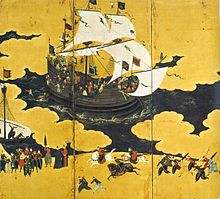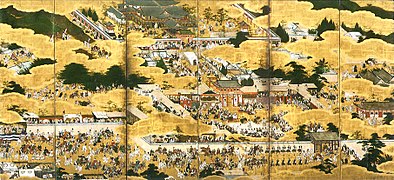Kanō Naizen
Kanō Naizen ( Japanese 狩 野 内 膳 , real first name Shigesato ( 重 郷 ), Shigenobu ( 重 信 ), first name Kyūzō ( 久 蔵 ); born 1570 ; died May 18, 1616 ) was a Japanese painter of the Kanō school during the Azuchi-Momoyama - and early Edo period .
life and work
Kanō Naizen was a student of Kanō Shōei , then was adopted by the Kanō family. During the Keichō period (1596-1614) he worked for the powerful Toyotomi family . When an elaborate ceremony was held in 1604 for the seventh recurrence of the death of the military leader Toyotomi Hideyoshi , Naizen recorded this event on two screens. This screen pair, called "The Festival at the Hokoku Shrine" ( 豊 国 祭礼 図 屏風 , Hokoku sairei byōbu ), which is regarded as his best work, is now in the possession of the Hokoku Shrine.
Other pairs of screens come from Naizen, depicting the "southern barbarians" ( 南蛮 , Namban), a nickname given to the Europeans who appeared in Japan, when they landed in Nagasaki . - Naizen seems to have specialized in genre painting in general.
His son Ikkei Shigeyoshi ( 狩 野 一 渓 重 良 ; 1599–1662) was also active as a painter, also known under the name Naizen. - He compiled the earliest collection of artist biographies in Japan, the Tansei jakuboku-shū ( 丹青 若 木 集 ).
photos
Remarks
- ↑ The Hōkoku Shrine ( 豊 国 神社 ) was built in 1599 to commemorate Hideyoshi in Kyoto.
literature
- Tazawa, Yutaka: Kanō Naizen . In: Biographical Dictionary of Japanese Art. Kodansha International, 1981. ISBN 0-87011-488-3 .
- Laurance P. Roberts: Naizen . In: A Dictionary of Japanese Artists. Weatherhill, 1976. ISBN 0-8348-0113-2 .
Web links
| personal data | |
|---|---|
| SURNAME | Kanō, Naizen |
| ALTERNATIVE NAMES | 狩 野 内 膳 (Japanese); Shigesato (real first name); 重 郷 (real first name, Japanese) |
| BRIEF DESCRIPTION | Japanese painter |
| DATE OF BIRTH | 1570 |
| DATE OF DEATH | May 18, 1616 |



